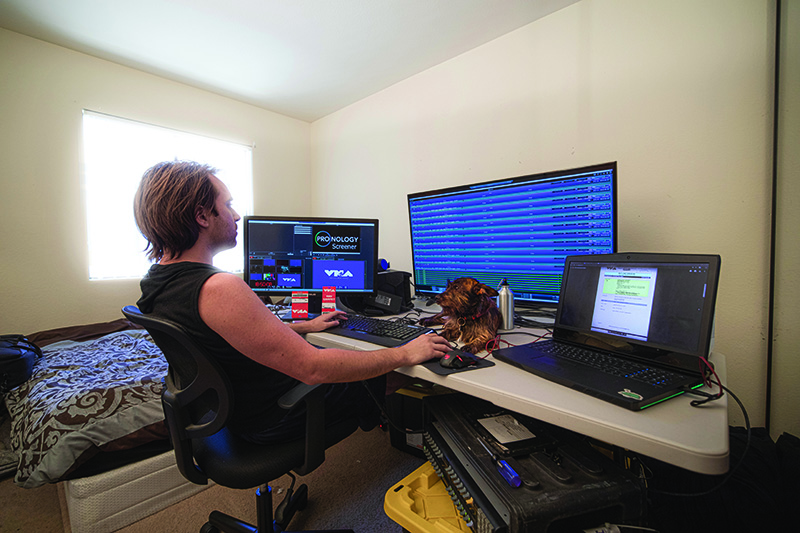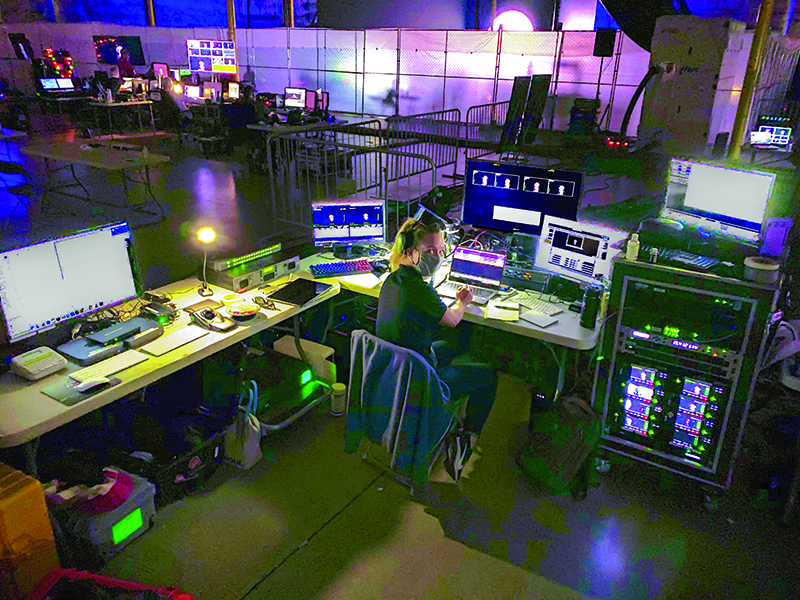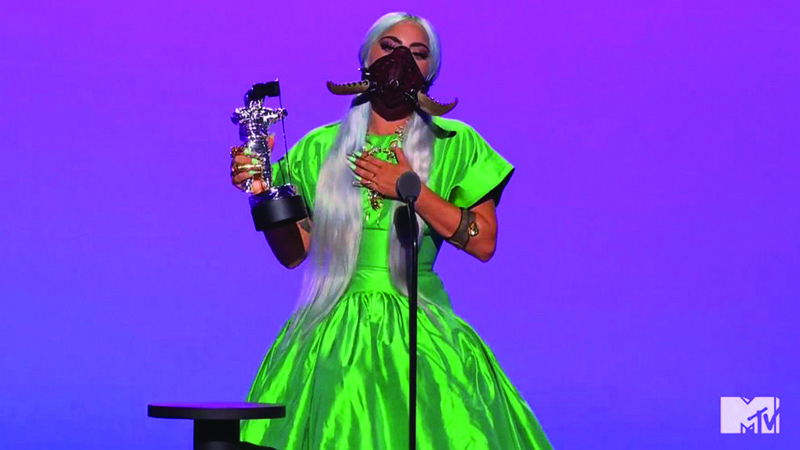Recording MTV’s Video Music Awards from My Bedroom
by James Delhauer

On September 14, 1984, the first Video Music Awards presented by MTV aired live from New York and began a tradition of excellence that continues to this day. Though initially conceived as an alternative network competitor to the popular Grammy Awards, the VMA’s grew in size and prestige to the point that the Moon Person Trophy is now a distinctly coveted prize among artists. The production became an annual spectacle that united creatives and audiences around the world. Year after year, craftspeople innovated creative solutions to new challenges in order to make the spectacle bigger and grander. Then 2020 happened. In light of the SARS-CoV 2 novel coronavirus pandemic, there was a great deal of uncertainty about whether or not the show would go on. Social distancing orders, safer-at-home recommendations, and travel restrictions made it impossible to assemble the necessary talent to put on a live event of that scale. The transition from a live to pre-taped experience presented new challenges for the Local 695 Video Engineers tasked with recording the show.
Traditionally, this particular awards show would air from a single location. New York, California, Florida, Nevada, and most recently New Jersey have all played host to the VMA’s at one time or another. The pandemic made it impossible to safely achieve that sort of gathering and so artists and craftspeople in different parts of the country had to come together to remotely build a show worthy of the production’s legacy. Performances were recorded by separate teams in California and New York. This normally live event was shot over the course of seventeen rigorous days. COVID testing and contact tracing protocols were put into place. Skeleton crews worked in shifts with sanitation breaks scheduled regularly. Anyone who could work remotely did.

Personally, I was surprised that my job could be done from home.
In recent years, Viacom and MTV have opted to record the VMA’s utilizing a server-based media platform called Pronology mRes. Instead of recording a single camera signal to a single memory card that must be offloaded and then transcoded before an editor’s work can begin, server-oriented recording allows engineers to simultaneously record multiple cameras directly to multiple storage units. This unique standalone encoder is capable of recording three tiers of compressed or uncompressed video per input channel—allowing recordists to deliver a high-resolution media file, an edit proxy, and a streamable proxy as soon as the director yells “cut.” This is achieved by routing camera signals into a series of mRes servers and then networking them to multiple pieces of network attached storage via a high bandwidth network switch. In recent years, the go-to network attached server unit for the job has been the solid-state drive-based rNAS, also from Pronology. The video from the SDI inputs is stored in an uncompressed format on the mRes server’s internal drives and then an operator utilizes timecode to select “in” and “out” points to create media files across multiple pieces of storage on the network. In conjunction with a transfer client application, post-production media can be wirelessly delivered from site to post in near real time.
So imagine my surprise when I got the phone call saying, “Yeah, you’re going to be doing all of that from your apartment.”
I had no idea how I was going to do that.
And so, discussions began as to how we would achieve a herculean task. We needed to record every camera of the performances in New York in real time, create a primary and a backup copy on site, forward a copy of the complete show to Geiger Post so they could splice it with content being shot in Los Angeles, and deliver screeners to producers for review—all without me ever leaving my bedroom.
First and foremost, I had to clean my apartment. Potentially historic television couldn’t be made in my home if I was tripping over pandemic clutter. After coming to terms with and conquering a lifelong problem with hoarding, I set to work preparing my space for the show.
I needed to be able to take remote control of up to twelve servers at one time and needed to be able to switch between them rapidly. I utilized two computers as controller devices while a third allowed me to maintain rapid communication via email, Slack, and text messages—all of which came in rapidly throughout the shoot. Every TV and monitor in my apartment was drafted into service just so I could keep track of all the devices on site.
On day one of prep, the leg of my desk broke off and I was forced to replace it with a series of pop-up tables from my garage. The production mailed a comms PL system to my address, which would allow me to communicate with various parties on site and in remote locations during work. Installing this upstairs in my room required me to run an Ethernet cable downstairs and across the living room to my router. Of course, it wasn’t quite long enough and some furniture had to be slightly rearranged to move things closer together.
In New York, mobile truck engineers on site powered on the twelve required servers, routed the camera signals to them, installed the network attached storage, configured a high-speed internet pipeline, and gave me Wi-Fi access to two of the machines on the network. It quickly became a game of the blind leading the blind as I communicated with NEP Group’s Dave Goodman, Jeff McEntire, and Orin Smith in order to describe what buttons to push and what ports to use when I couldn’t see what they were doing. Likewise, I would often have to work off of equally vague and confusing descriptions from them in order to make things work on my end. Eventually, we found success and I was able to take remote control of those two machines using Remote Desktop Connection, a Windows-based networking application designed to facilitate remote computer repair work. I was then able to make the computer I was remote controlling take remote control of any other machine on the network, allowing me to control any of the twelve machines I needed through just the two Wi-Fi-enabled ones and transfer data to all necessary destinations.

Once I had access, I passed control to Thayne Knop, a networking and IT expert at Viacom, who set up a Signiant Transfer Client and watch folder on the network, giving us the ability to upload files directly to Lead Editor Hector Lopez at Geiger Post. During the show, the First Assistant Director would call for a record to begin via the PL system. Using one remote control, I would begin recording the show for the editors and with the other, I would make a screener copy for producers and talent. When they called for a cut, I would migrate a copy of the recorded segment into the Signiant Transfer Client watch folder, which would upload a copy of the media directly to the post-production team over a high-speed connection. This allowed editors to begin cutting the show together mere minutes after the performance concluded. Terabytes of data were transferred across multiple network attached storage pieces and I never stepped in within 3,000 miles of it.
In 2019, this workflow would have been laughable. Setting up a daisy chain of twelve computers remote controlling one another so that the show could be recorded from home without ever having to get out of bed is a joke that plenty of recordists used to make on set. It was the sort of thing that someone would say to a tech manager, who would laugh it off before telling everybody to get back to work. Now that joke has become a potentially life-saving precaution.
This process was not without its flaws. My home internet dropped out once. Sometimes I’d have to hop on the PL and ask someone to go push a button if a machine needed to be rebooted, which is just so much more inconvenient for all parties involved than it sounds like it should be. Watching a video feed via remote control is inherently unreliable as the image degrades and drops out constantly, meaning I had no true quality control capability from my location. The equipment in New York often reacted at a slight delay to my input commands in California, leading to some delays for production. As more segments were added to the transfer queue, the network on site slowed down considerably and I lost my connection to it several times. That was scary.
For the Los Angeles end of production, a fully remote recording workflow was not possible. My counterpart on the production, 695 Vice-President Jillian Arnold, has helped shape and develop the workflow for every VMA’s show in the last four years. In keeping with its tradition of ever grander spectacle, Viacom enlisted XR Studios to facilitate virtual reality-based screens and projection content—necessitating a more hands-on recording workflow. Jillian’s records featured a mixture of content of varying frame rates and resolutions, as well as a mixture of recording platforms. Content captured using an mRes system was able to be sent directly to Geiger in a manner similar to my own workflow but content recorded utilizing AJA’s KiPro decks needed to be manually offloaded to local storage before being uploaded. This required several overnight transfers and careful management of digital real estate as upward of 30 terabytes of data were recorded across the shoot.
But we did it. On August 30, MTV brought their award ceremony back for its 37th annual broadcast and 6.4 million people tuned in to see Lady Gaga steal the night. Now, more productions are following the VMA’s in safely returning us to work.
In spite of the sheer volume of sanity destroying negatives associated with the COVID-19 pandemic and 2020 as a whole, there is something to be said for the innovation that’s been made in what will (hopefully) be remembered as the worst year of our lives. Emerging communication technology and infrastructure have allowed us to adapt in ways few would have imagined just a year ago. In March, the sets of Hollywood went dark as social distancing protocols, safer-at-home recommendations, and travel bans were implemented nationwide. And while the end of the pandemic is still a ways away, production was able to resume in just six months. Comical and outside of the box thinking is overcoming unprecedented challenges. Remote working solutions and new set procedures agreed upon with the AMPTP in compliance with CDC guidelines have allowed us to resume our craft. And what we learned from early productions such as this year’s MTV Video Music Awards ceremonies have informed our workflows on productions going forward. Moreover, our achievement in adapting to the current crisis and continuing our craft as artists cannot be understated. New infrastructure, technology, and responsibilities may put us in the enviable position of being more in demand than we were before the pandemic in spite of the push to move workers off set. Now it’s up to us to prepare for this coming moment of opportunity so that we may grasp and use it to get our lives back on track and begin to move past this entire dystopian tragedy.